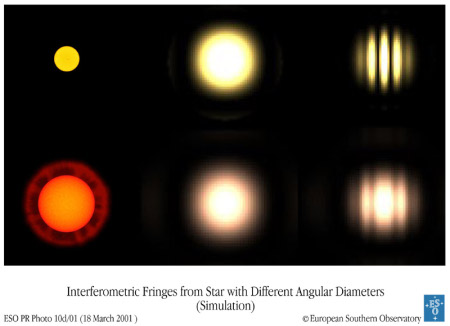Most Centauri Dreams readers will be familiar with the concept of interferometry by now. The idea is to combine light from multiple telescopes, allowing the combined array to act like a single telescope with a diameter equivalent to the distance between the telescopes. Thus we have the European Southern Observatory’s VLTI (Very Large Telescope Interferometer), which uses two telescope elements some 200 meters apart. The VLTI has now put a new instrument called PRIMA into operation, with useful exoplanetary implications.
PRIMA (Phase Referenced Imaging and Microarcsecond Astrometry) is designed to pick out the tiny motions a star makes as it is influenced by unseen planetary companions. We’ve long studied such wobbles in stars through radial velocity methods — these analyze the light from the star, determining through Doppler shifts in the star’s spectrum how a companion object may be influencing it. But PRIMA will find the wobbles through actual imaging, using incredibly precise astrometric measurements. The images below, although not based on PRIMA, illustrate the basic operation of interferometry.

Image: The difference between two stars of different diameter is illustrated. While the image of the smaller star displays strong interference effects (i.e., a well visible fringe pattern), those of the larger star are much less prominent. The “visibility” of the fringes is therefore a direct measure of the size; the stronger they appear (the “larger the contrast”), the smaller is the star. Credit: ESO.
This ESO news release talks about measuring angular differences of about ten micro-arcseconds using the PRIMA instrument, good enough for gas giant detections. We’ll do much better than that once we have future space-based observatories tuned for astrometry, but for now this is state of the art stuff. The first starlight fed into PRIMA reached it on September 2. In interferometer lingo, this is not ‘first light’ but ‘first fringes,’ since it refers to the first time the light from different instruments was combined to produce the pattern of bright and dark lines known as interferometric fringes. The differences between the signals allow astronomers using these instruments to measure angles to exquisite precision.

Image: If the distance between the two telescopes is increased when a particular star is observed, the fringes become less and less prominent. At a certain distance, the fringe pattern disappears completely. This distance is directly related to the angular size of the star. Credit: ESO.


Tens of microarcseconds? Now that is impressive… stands a chance of being able to detect multiple planets in some currently-known systems. E.g. should be enough to detect the outer two planets at Upsilon Andromedae, 2-3 of the planets at Mu Arae, and maybe both of the resonant planets around Gliese 876. This will enable us to finally answer the question of whether exoplanetary systems are in fact coplanar, or if high mutual inclinations are the norm.
The Carnegie Astrometric Planet Search Program
Authors: Alan P. Boss, Alycia J. Weinberger, Guillem Anglada-Escude, Ian B. Thompson, Gregory Burley, Christoph Birk, Steven H. Pravdo, Stuart B. Shaklan, George D. Gatewood, Steven R. Majewski, Richard J. Patterson
(Submitted on 10 Sep 2009)
Abstract: We are undertaking an astrometric search for gas giant planets and brown dwarfs orbiting nearby low mass dwarf stars with the 2.5-m du Pont telescope at the Las Campanas Observatory in Chile.
We have built two specialized astrometric cameras, the Carnegie Astrometric Planet Search Cameras (CAPSCam-S and CAPSCam-N), using two Teledyne Hawaii-2RG HyViSI arrays, with the cameras’ design having been optimized for high accuracy astrometry of M dwarf stars.
We describe two independent CAPSCam data reduction approaches and present a detailed analysis of the observations to date of one of our target stars, NLTT 48256.
Observations of NLTT 48256 taken since July 2007 with CAPSCam-S imply that astrometric accuracies of around 0.3 milliarcsec per hour are achievable, sufficient to detect a Jupiter-mass companion orbiting 1 AU from a late M dwarf 10 pc away with a signal-to-noise ratio of about 4.
We plan to follow about 100 nearby (primarily within about 10 pc) low mass stars, principally late M, L, and T dwarfs, for 10 years or more, in order to detect very low mass companions with orbital periods long enough to permit the existence of habitable, Earth-like planets on shorter-period orbits.
These stars are generally too faint and red to be included in ground-based Doppler planet surveys, which are often optimized for FGK dwarfs. The smaller masses of late M dwarfs also yield correspondingly larger astrometric signals for a given mass planet.
Our search will help to determine whether gas giant planets form primarily by core accretion or by disk instability around late M dwarf stars.
Comments: 48 pages, 9 figures. in press, Publ. Astron. Soc. Pacific
Subjects: Instrumentation and Methods for Astrophysics (astro-ph.IM)
Cite as: arXiv:0909.2008v1 [astro-ph.IM]
Submission history
From: Alan Boss [view email]
[v1] Thu, 10 Sep 2009 18:11:56 GMT (2207kb)
http://arxiv.org/abs/0909.2008